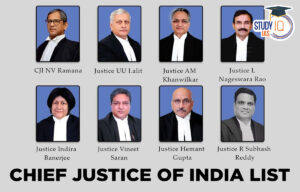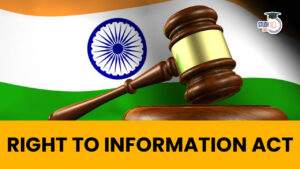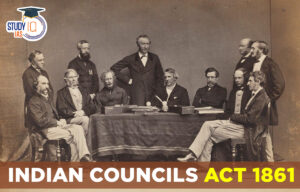Table of Contents
Union and Its Territory
Part 1 of the Indian Constitution, Articles 1 to 4, deals with the union as well as its territory. India is called the Union of States even though the Constitution of India is federal in structure. The reasons for it were given by Dr. B. R. Ambedkar. He preferred “Union of States” over “Federation of States” for two reasons:
- The Indian Federation is not the result of an agreement among states like the American Federation.
- The right to secede from the federation is not available to the states.
Read About: Kesavananda Bharati Case
Union and Its Territory Articles
Part 1 of the Constitution of India, from Article 1 to Article 4 expressly deals with the Indian Union and its Territories which is given below in the table:
| Article 1 | Name and territory of the Union. |
| Article 2 | Admission or establishment of new States. |
| Article 2A | Sikkim to be associated with Union (Repealed) |
| Article 3 | Formation of new States and alteration of areas, boundaries or names of existing States. |
| Article 4 | Laws made under articles 2 and 3 to provide for the amendment of the First and the Fourth Schedules and supplemental, incidental and consequential matters. |
Read More: Right to Equality
Article 1 of Indian Constitution
Article 1 of the Indian Constitution states that India, that is Bharat, shall be a union of states. This deals with two things: the name of the country and the type of Polity.
Article 1 (2) states that all the states and territories must be specified in the First Schedule of the constitution.
Article 1 (3), states that the territory of India comprises:
- The territories of the States;
- The Union territories specified in the First Schedule; and
- Territories that may be acquired by the Indian government in future.
India has been described as a ‘Union’ although its constitution is federal in structure. The country has been divided into different states only for the convenience of administration but no state can separate itself from the union. The Federation is a Union because of its indestructible nature. No state has the right to separate itself from the Indian union.
The constitutional makers had divided the country into governable units (States and union territories) to ensure better governance and for providing a safe space to our multi-ethnic and multi-cultural population. It must be noted that the term ‘territory of India’ is a wider expression than ‘Union of India’.
- Union of India: All the states in India form part of the Union of India.
- Territory of India: Territory of India includes not only the states but also union territories and territories that may be acquired by the Government of India at any future time.
The governance of these units will be discussed in later chapters. It must be noted that the acquisition of foreign territory does not fall within Article 1. It is governed by international laws.
Read More: Right to Freedom
Article 2 of Indian Constitution
Article 2 of the Indian Constitution article empowers the Parliament to add or establish new states in the Union of India. The terms and conditions of such addition or establishment are decided by the Parliament. Two powers which are given to the Parliament under the article are:
- Power to admit new states in the union of India i.e., admission of states which are already in the union.
- Power to establish new states i.e., states which were not in existence before.
Read More: Articles 12 and 13
Article 2A: Sikkim to be associated with the Union [Repealed]
This is how Sikkim was added to our Union of states. It stood as an independent monarchy before in 1975, its subjects voted by plebiscite to become a state of India. This article was inserted into the Constitution by the Thirty-Fifth Amendment Act of 1974. This Article however has been repealed by the Thirty-Sixth Amendment Act 1975.
Read More: Article 14 of Indian Constitution
Article 3 of Indian Constitution
Under Article 3 of the Indian Constitution, the parliament has been given the following powers:
- The Parliament can create new states out of existing states. For example, the Creation of Telangana out of Andhra Pradesh; Uttarakhand out of Uttar Pradesh; Punjab state by merging Patiala and East Punjab States Union (Pepsu) etc.
- Under the act, Parliament can increase or diminish the area of any state.
- Parliament can alter the boundaries of any state.
- Parliament has the power to alter the name of the state.
- The power conferred on Parliament to form a new state or union territory includes the power to unite a part of any state or union territory to any other state or union territory for the formation of the new state.
There are 2 special conditions that have to be fulfilled before parliament decides to create new states, or alter areas or boundaries of existing states:
- Prior Recommendation of the President: This bill can only be introduced in parliament with a prior recommendation of the President
- State Legislature View: The President before recommending this bill in parliament has to refer the bill to the concerned state’s legislature so that the state can express its views on the bill. The power of the state legislature is limited in the case of the bill (a unitary feature of the constitution):
- Non-binding: State’s views are not binding and the President (or the Parliament) can choose to ignore the state’s suggestions.
- No Reference for New Changes: If new changes are made in the bill, it is not necessary to refer that bill to the concerned state again for its views.
- Provision in Case of Union Territories: If the bill is related to a Union territory with a state legislature in it (such as Delhi and Pondicherry at the moment), no reference is needed to be made to that legislature for its view on the bill.
|
Fundamental Difference Between the Provisions of Article 2 and Article 3 |
There is a fundamental difference between the provisions of Article 2 and Article 3. Even though they both are related to creating states,
|
The territorial integrity of states is not important and is subject to parliamentary legislation. It can be easily understood that the integrity of the union of India is more important than the territorial integrity of its constituent states.
For example, in the case of Jammu and Kashmir, for better governance and the needs of the people of Ladakh, the territorial boundaries of the erstwhile Jammu and Kashmir state were modified to create a new union Territory of Ladakh. States are dispensable, but the unity and integrity of India are not.
Read More: Article 15 of Indian Constitution
Union and Its Territory Renamed States
| Year of Name Change | Name Before | Name After |
| 1950 | United Provinces | Uttar Pradesh |
| 1956 | Madhya Bharat | Madhya Pradesh |
| 1969 | Madras | Tamil Nadu |
| 1973 | Mysore | Karnataka |
| Laccadive, Minicoy and Amindivi Islands | Lakshadweep | |
| 1992 | Union Territory of Delhi | National Capital Region of Delhi |
| 2006 | Uttaranchal | Uttarakhand |
| Pondicherry | Puducherry | |
| 2011 | Orissa | Odisha |
Note: This list may include all the states formed after merging or altering the boundaries of states.
Read More: Article 16 of Indian Constitution
Under Article 3 Laws made by Parliament
| State/Act | Acts and Provisions |
| Assam | Assam (Alteration of Boundaries) Act, 195, Parliament enacted this act for ceding a strip of territory to Bhutan by altering some part of the boundary Assam. |
| Andhra | Andhra State Act, 1953, this act made by the parliament Andhra was Formed and became India’s first linguistic state.
Andhra Pradesh and Madras (Alteration of Boundaries) Act, 1959, the act altered the boundaries of the state of Andhra Pradesh and Madras. Andhra Pradesh and Mysore (Transfer of Territory) Act, 1968, provided the transferred territory from Mysore to the State of Andhra Pradesh. |
| Himachal Pradesh | Himachal Pradesh and Bilaspur (New State) Act, 1954, formed a new state of Himachal Pradesh by merging the state of Himachal Pradesh and an area named Bilaspur. |
| West Bengal | Chandernagore a former French territory was merged into West Bengal by the enactment of the Chandernagore (Merger) Act, 1954.
Bihar and West Bengal (Transfer of Territories) Act, 1956, it transferred some territory of Bihar to west Bengal. |
| States Reorganisation Act, 1956 | In 1956 after the recommendation of the Fazal Ali commission Parliament enacted this act which made extensive changes in the boundaries of various states for the purpose of meeting the linguistic, geographical, regional and local demands. It created 14 states and 6 union territories. |
| Gujarat | Bombay Reorganisation Act, 1960, Parliament created the 15th state by carving out Gujarati speaking population from Bombay and named it Gujarat by this act and changed the name of Bombay to Maharashtra. |
| Nagaland | State of Nagaland Act, 1962, Parliament through this act created the 16th State of India i.e., Nagaland by carving out the Naga Hills (especially Tuensang Region) of Assam. The Naga Hills (Tuensang Region) is a tribal area of Assam specified in the 6th Schedule of our Constitution. |
| Haryana | Punjab Reorganisation Act, of 1966, created a new state of Haryana the 17th state by carving out the Hindi-speaking region of Punjab and Chandigarh was made the Union Territory and capital of both states. |
| Himachal Pradesh | State of Himachal Pradesh Act, 1970, the act made Himachal Pradesh its 18th state which was a union territory initially. |
| Manipur, Tripura and Meghalaya | North-Eastern Areas (Reorganisation) Act, of 1971, created the 19th, 20th and 21st states of India which was Manipur, Tripura and Meghalaya. It also created two union territories of Mizoram and Arunachal Pradesh. |
| Mizoram | State of Mizoram Act, 1986, the union territory of Mizoram was given the status of 23rd state of India. |
| Arunachal Pradesh | State of Arunachal Pradesh Act, 1986, the union territory of Arunachal Pradesh was given the status of 24th state of India. |
| Goa | Goa, Daman and Diu Reorganisation Act, 1987, formed a new state of Goa the 25th state of India by separating the territory of Goa from the Union Territory of Goa, Daman and Diu. |
| Chhattisgarh | Madhya Pradesh Reorganisation Act, of 2000, it created the state of Chhattisgarh (26th state) out of the territories of the State of Madhya Pradesh. |
| Uttaranchal | Uttar Pradesh Reorganisation Act, 2000, State of Uttaranchal (27th state) by carving out its territory from that of the territories of the state of Uttar Pradesh.
Uttaranchal (Alteration of Name) Act, 2006, altered the name of the State of Uttaranchal to that of the State of Uttarakhand. |
| Jharkhand | Bihar Reorganisation Act, 2000, State of Jharkhand (28th state) by separating its territory from the territories of the State of Bihar. |
| Telangana | Andhra Pradesh Reorganisation Act, 2014, state of Telangana (29th state) by carving out its territory from the territories of the state of Andhra Pradesh. |
| Note |
|
Read About: Indra Sawhney Case
Article 4 of Indian Constitution
Laws made under articles 2 and Article 3 provide for the amendment of the 1st and the 4th Schedules and supplemental, incidental and consequential matters: There are two parts to this article:
- Any law which contains provisions under Article 2 or Article 3 shall contain provisions for the amendment of the 1st schedule and the 4th Schedule which shall be necessary.
- No such law made under this article shall be considered as an amendment under Article 368.


 Justice BR Gavai will take oath as 52nd ...
Justice BR Gavai will take oath as 52nd ...
 Right To Information Act, Objective, Fea...
Right To Information Act, Objective, Fea...
 Indian Councils Act 1861, History, Provi...
Indian Councils Act 1861, History, Provi...





















